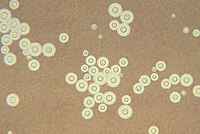
Photo from wikipedia
Cryptococcus neoformans is a fungus that is able to survive abnormally high levels of ionizing radiation (IR). The radiolysis of water by IR generates reactive oxygen species (ROS) such as… Click to show full abstract
Cryptococcus neoformans is a fungus that is able to survive abnormally high levels of ionizing radiation (IR). The radiolysis of water by IR generates reactive oxygen species (ROS) such as H2O2 and OH-. C. neoformans withstands the damage caused by IR and ROS through antioxidant production and enzyme-catalyzed breakdown of ROS. Given these particular cellular protein needs, questions arise whether transfer ribonucleic acids molecules (tRNAs) undergo unique chemical modifications to maintain their structure, stability, and/or function under such environmental conditions. Here, we investigated the effects of IR and H2O2 exposure on tRNAs in C. neoformans. We experimentally identified the modified nucleosides present in C. neoformans tRNAs and quantified changes in those modifications upon exposure to oxidative conditions. To better understand these modified nucleoside results, we also evaluated tRNA pool composition in response to the oxidative conditions. We found that regardless of environmental conditions, tRNA modifications and transcripts were minimally affected. A rationale for the stability of the tRNA pool and its concomitant profile of modified nucleosides is proposed based on the lack of codon bias throughout the C. neoformans genome and in particular for oxidative response transcripts. Our findings suggest that C. neoformans can rapidly adapt to oxidative environments as mRNA translation/protein synthesis are minimally impacted by codon bias.
Journal Title: PLoS ONE
Year Published: 2022
Link to full text (if available)
Share on Social Media: Sign Up to like & get
recommendations!